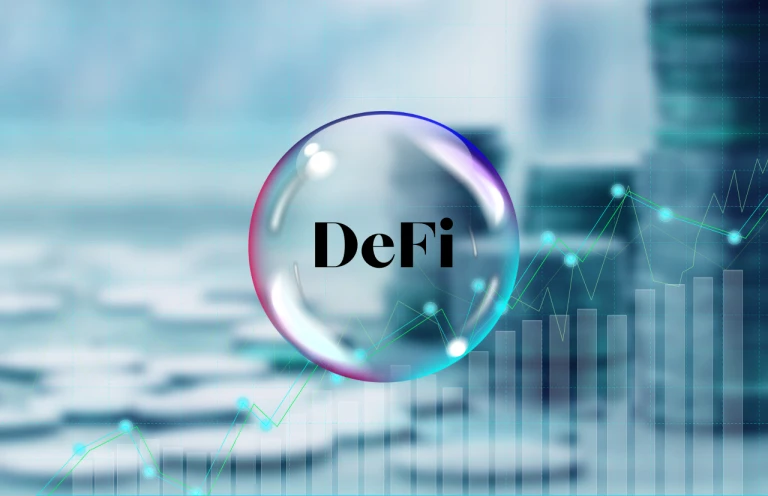Decentralized Finance: How DeFi will change Financial world?

The decentralised finance movement is gathering pace. But what exactly is it? And how will it change the financial world as we know it? In this blog post, we will explore the DeFi movement and how it is changing the financial world.
What is DeFi?
Looking at the two parts of the term separately can help you understand it better.
”De” = Decentralized
The “de” in DeFi stands for “decentralised” or “distributed control.” DeFi transforms a previously centralised governance model into a decentralised one. Controlled by no one by removing power from the hands of a few central authorities. Distributing it across programmatic and autonomous code.
”Fi” = Finance
The “Fi” in DeFi stands for “finance,” and it specifically refers to financial services. Traditional finance has been disrupted by DeFi. Which has transformed popular and long-standing financial services into decentralised versions with no central authority. DeFi provides an alternative to traditional financial services such as:
- Borrowing
- Lending
- Investing
- Trading
- Saving
- Insurance
- Crowdfunding
- Crowdraising
This means that anyone with an Internet connection can access financial services without having to go through a middleman. This not only makes it easier for people to use financial services. But also opens up a whole world of new possibilities that were not possible before.
DeFi has also facilitated the development of new financial products:
- Cryptographic tokens: These digital assets come in a variety of forms, the most common of which is a “utility token,” which serves a specific function within a digital ecosystem. The Basic Attention Token (BAT) is one example, which is used as payment for advertisers, users, and content creators on the Brave browser.
- NFTs (Non-Fungible Tokens): These tokens convert digital images (such as works of art, tweets, video clips, and GIFs) into distinct assets that can be traded on a blockchain.
How does DeFi work?
Services and products are approved by smart contracts rather than a small group of decision makers in DeFi. Smart contracts, like traditional contracts, contain information and terms pertaining to transactions between parties, but they are entirely digital. They operate similarly to a small computer programme stored within a blockchain, a permanent and ever-growing record of information and transactions stored in individual blocks.
DeFi has many similarities to cryptocurrencies, including the following:
Permissionless/Borderless
DeFi applications are permissionless—they are completely free to use and are available to anyone with an internet-connected smartphone or computer. DApps, unlike traditional financial services, do not require lengthy applications to create an account because users interact with smart contracts directly from their crypto wallet.
DeFi applications are also borderless, which means they are not country-specific and do not discriminate against users based on citizenship, geographic location, or political affiliation. Anyone can use a DeFi app to access funds in one country, travel to another, and access their funds without any restrictions.
Transparent
DeFi applications are built on top of a blockchain network, which is a distributed ledger made up of smart contracts that stores transaction details as they happen and builds on top of them. Transaction activities are permanently recorded in the blockchain’s history of transactions across the entire network, while new ones are constantly added.
Transaction records cannot be hidden or altered because smart contracts and blockchain technology are designed to be permanent and publicly visible. Because addresses are not directly linked to personal identities, all transaction activities can be seen by all market participants without invading privacy. It also enables anyone to audit the code and identify bugs.
No third parties
DeFi recognises and avoids traditional finance’s trust problem by reducing the need for third parties, banks, and clearinghouses. Users interact with self-executing smart contracts based on conditions being met in most DeFi apps, rather than waiting for approval from overseeing stakeholders.
How DeFi is disrupting traditional financial services
Borrowing, lending, and investing have traditionally been areas with a high barrier to entry, preventing people with little money or financial expertise from accessing these services.
Though traditional banking is common in first world countries, there are over 1.7 billion people who are unbanked globally , representing over 30% of the human population
World Bank Global Findex report.
Decentralized finance vs. traditional finance is a contentious issue. The two differ primarily on three points.
- A public blockchain serves as the trust source in decentralised finance, governing all financial operations. In contrast, public governance, which includes laws and licenced financial institutions, serves as the source of trust, governing all traditional finance operations.
- Decentralized finance is gaining popularity because it is more open and transparent than traditional finance. The lack of barriers to entry means anybody with programming skills can take part in building financial services and tools on top of public blockchains.
- In contrast, high entry barriers have made it unlikely that the traditional financial system will embrace the emerging trend. The requirement to obtain proper licences and authorization from regulators has stifled innovation in traditional finance systems.

What’s a DApp?
A decentralised application, or DApp, is a digital programme that runs on a decentralised blockchain network and is not controlled by a single authority. DApps are open-source and serve as the foundation for any cryptocurrency project; Bitcoin is regarded as the first DApp.
While DApps are typically ‘unownable’ services, DApps may distribute underlying tokens that allow users to purchase cryptocurrency.
DApps are similar to centralised applications but benefit from the decentralised blockchain network’s features. They are thought to be more secure against cyberattacks because they lack a single point of failure. A distributed network of nodes keeps the network running and prevents system downtime, which is common in centralised applications. DApps are not owned by anyone and are not susceptible to owner misbehaviour such as embezzlement.
Examples of DeFi DApps
DeFi is a relatively new market, with live products first appearing in 2017 or so. Here are some of the most common types of DApps that appeared in 2020:
Borrowing and Lending Platforms
Securing a traditional loan typically entails submitting an application with ample personal information to a financial institution, agreeing to a credit check, pledging collateral (if necessary), and waiting for interest to be factored in by the intermediary for facilitating the loan that is sourced by a federal institution. DeFi smart contracts connect interested lenders and borrowers, impose loan terms, and impose interest without the involvement of a third party. Lending DApps typically require collateral in the form of crypto or stablecoins to be pledged as a means of insuring the lender’s risk. DApp lending platforms have formed loans with interest rates as low as 10% through smart contract automation and the elimination of a third-party intermediary.
Decentralized Exchange (DEX)
A decentralised exchange (DEX) is a type of exchange that uses smart contracts to enforce trading rules, execute trades, and handle funds securely if necessary. DEXs, unlike centralised exchanges, do not require account creation, identity verification, or the payment of exchange fees. Because DEXs are distinct and lack centralised authority, it is debatable whether some or all DEXs are subject to the crypto regulations that apply to centralised exchanges. Further, many DEX’s do not custody users’ funds at any point during trading, adding additional uncertainty as to the application of regulations. However, they, like any other exchange, require liquidity in order to match buyers and sellers.
Betting Platform
DeFi challenges one of the most restricted and centralised industries in existence: gambling. In addition to a lengthy and exclusive registration process, users of traditional online gambling platforms may have their betting limits reduced or their accounts closed. This is not possible with a decentralised peer-to-peer platform.
Several betting DApps have been launched as limitless global betting platforms. Allowing users to bet on traditional sports events as well as real-world events such as economics, pop culture, and more. Users can place bets with digital currencies and be rewarded in them if they win. Users bet on the outcome of an event, and the DApp displays the current odds based on active user bets.
NFT Marketplace
The launch of marketplaces for exchanging non-fungible tokens, or NFTs, has been an innovative DeFi development. NFTs are one-of-a-kind cryptographic tokens that represent digital goods. Like online gaming goods as well as real-world assets like art, collectibles, company equity, and commodities. An NFT marketplace enables users to freely buy, sell, and trade non-fungible assets represented by NFTs.
DeFi Extending to the insurance industry
Decentralised finance, or “DeFi”, is a term used to describe the shift from traditional centralised financial systems to peer-to-peer finance enabled. By decentralized technologies built on the Ethereum blockchain. This move towards DeFi is being driven by a number of factors, including the increasing trust in decentralized systems. The need for more open and transparent financial systems, and the desire for greater control over one’s own finances.
One area where DeFi is starting to have an impact is the insurance industry. In traditional insurance models, policyholders are at the mercy of insurance companies when it comes to claims processing and payouts. However, with DeFi protocols such as Nexus Mutual, policyholders can take out smart contracts that directly cover them against specific risks.
As DeFi continues to grow and evolve. We can expect to see it have an increasingly significant impact on the insurance industry and other areas of finance.
The bottom line
While the use of digital ledger technologies in the global financial system is still in its early stages. But its ultimate potential cannot be denied. Decentralized finance has the potential to transform the financial sector.
The fact that DeFi could provide banking services to so many people in areas. Where traditional finance has failed highlights its enormous potential.
If decentralised finance is to replace today’s financial system, it must first address a number of issues. Related to scalability, security, liquidity, and regulations.
Follow us on Instagram.









